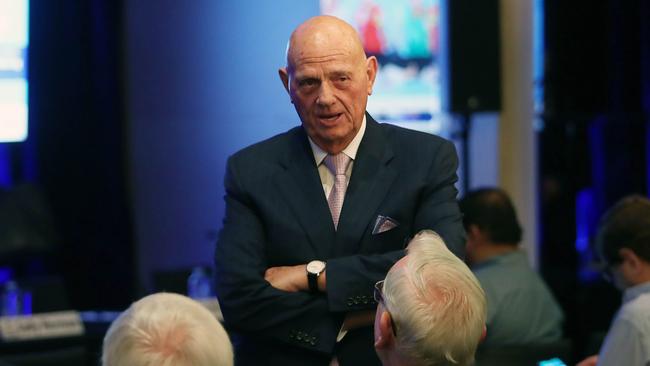What retail stores need to do to compete with online shopping post-Covid
It might look a lot like Christmas but can our favourite department stores really bounce back from the twin hits of the online shopping boom and the pandemic? We ask the experts.

Fashion
Don't miss out on the headlines from Fashion. Followed categories will be added to My News.
We used to dress up to go Christmas shopping. Now, we can do it wearing no clothes at all. Digital migration has certainly revolutionised retail therapy – a trend which has only accelerated since the Covid pandemic hit – and while there is life in traditional brick and mortar stores, they have a fight on their hands to stay relevant, say industry experts.
That’s reassuring for those of us who love to try before we buy. But what has to change to lure more of us away from the comfort of shopping in bed?
The answer lies in the theatre of in-store experiences and the magic of touch, smell and taste in immersive experiences we can’t get online. And sustainability is key.
NEW YORK STATE OF MIND
Damian Eales knows retail. But a recent relocation to New York has been a revelation, even for someone who started on the Myer shop floor at 14 and worked his way up the ranks for 10 years.
He then spent another 14 at rival David Jones, where he became a key lieutenant to then CEO Mark McInnes and led the department store chain’s marketing and financial services division, before moving on to Westpac and later News Corp (publisher of this magazine), where he is global head of transformation.
Eales noticed a startling difference in the way retail stores operate in the Big Apple while on a trip to buy an urgently needed ironing board for business shirts.

A familiar if tedious task here: You go to the store, pick out your board, find someone to serve you, pay for it, carry it back to the car, and haul it home.
Of course you could buy it online but then you have to wait days if not weeks (thanks Covid!) to receive the goods.
Not so in Eales’ new experience.
The ironing board was not physically in the store he went to, but was still on his doorstep within a matter of hours.
“Everything is delivered to your apartment, and that’s despite the fact that we walk past the shops every day,” Eales says.
“The logistics network has become so sophisticated and so good. In the US, you get deliveries on Saturdays, on Sundays, you get deliveries at night time.”
Eales says Australia’s logistics will catch up, but the future of retail also lies in in-store attractions that complement more efficient delivery times.
Which brings us to the second difference between shopping in New York and heading into a department store in Australia.
America’s big-name stores are evolving into showcases for a curated collection of goods, rather than being crammed to the gills with multiple variations of the same product that potential buyers have to sift through and may take months to move off shelves and racks.
“The expense of holding massive ranges in stores is becoming less economical,” Eales says.
“I went to Macy’s the other day and it was very visible that they had reduced their range during Covid so that it was (only) the core items (on show).”
Australia’s biggest brick and mortar stores need to follow suit, Eales says.
“It’s a particular issue for CBD stores – they need to become showcases more than traditional retailers. You can use the internet and the suburban stores to clear stock; these CBD locations, the Bondis, the Chatswoods, they need to become the showcase locations.”
That means less physical stores but the ones that remain will become marketing installations that really enhance the shopping journey.
“When I was in retail, we always used to talk about Nike Town in New York. It was the biggest innovation because you’d go in there and it would be such an experience and they weren’t selling that many shoes to pay for it, they paid for it out of their marketing budget,” Eales says.
“The initial Apple stores were paid for out of the marketing budget because it was seen as a better brand investment than running a television campaign.
“Another big trend is the Amazon effect of creating platforms whereby a brand can sell literally anything,” Eales adds.
For example, a retailer like Myer would traditionally sell 10 different items from a brand’s range. Now they’ll put eight items from that range in physical stores but another 100 online.
AT YOUR SERVICE
The recent Black Friday shopping frenzy saw record sales, and the Christmas trade is expected to be the biggest yet but while shops are open, pandemic problems remain, with staffing and supply chain issues threatening the industry so desperate to lure shoppers back through their doors.

Service is key, as is experience, says head of the Australian Retailers Association Paul Zahra.
That may mean value-adds for shoppers such as interactive make up tutorials, live cooking demonstrations, or having experienced staff offering advice on fashion trends or what garments work best for a shopper’s body type.
“It’s becoming more important that (stores) can solve problems that can’t be solved easily with technology. (Problems where) you need a human involved to resolve the issue,” Zahra says.
“Consumers are wanting to see much more theatre, much more experiential, much more personalised shopping, so the shopping aspect in stores is still significant.”
With 15 per cent of sales happening online, the majority of shopping is still done in store, Zahra points out.
“So although we will continue to see that online number grow, it’s more important that the physical experience is actually a good one because we’ve had to get dressed, leave the house and go and visit a store.”
But therein lies another challenge for brick and mortar stores.
Having borders closed to international students has resulted in a staffing shortage, which could be critical to the all important and notoriously busy Christmas trade.
“If they don’t get the staffing levels right, that may impact their trading performance, so we are saying to consumers, ‘shop early to avoid disappointment’,” Zahra warns.
WINDOW DRESSING
Old-school drawcards such as the Christmas windows in David Jones’ city store have never had a bigger role in attracting potential customers, says Damian Eales.
“Those theatrical moments, from a brand perspective, have never been more important – so those window displays should be invested in even more, not less,” he says, while also acknowledging the frustration for shoppers when there is not enough staff on the ground to meet demand when it does arrive.

“There’s a lot of cash in people’s pockets, so it will be a bumper Christmas no matter what but it is going to be challenging from that perspective.
“Every retailer in the world is warning right now that there are supply chain issues, so your first choice may not be (available in store).
“You can imagine having to go into the city or a shopping mall and your first choice isn't there so you have to go to another shop, and another shop (when) you can do that all on a computer or your mobile phone.”
DIGITAL REINVENTION
With Australian Retail Association and Roy Morgan research forecasting pre-Christmas sales will reach almost $59bn, Paul Zahra says that while online shopping has undoubtedly been a challenge for brick and mortar stores, the smart ones have added it to their repertoire, seeing it as an advantage rather than a deterrent.
“We have certainly seen that the pandemic has accelerated trends that were already occurring in the industry, so naturally there has been a seismic shift towards digital and what we call contactless shopping,” Zahra explains.
“And as a result, these stores are having to reinvent themselves.
“Online business has almost doubled since pre-pandemic numbers … but it’s not just shopping. It’s even the way retailers communicate with consumers.

“Retailers used to see digital as being a disruptive force, now they see it as an insurance because if they didn’t have a digital offering through Covid, they would not have survived.”
Shoppers are also increasingly doing their research at home before heading into a store, saving busy people precious time.
“So the store’s role becomes more important,” Zahra says.
“As there’s been this migration towards digital, the expectation from a service point of view has become significantly more. (Customers) are expecting that the omni-channel model (multichannel approach) is a seamless experience so they do the research online and they expect to find the inventory in store and at the price that they’ve seen it.
“So in-store, people’s experience has got to be improved.”
ROAD TO RECOVERY
Zahra says it could take five years for pandemic-impacted shops in Sydney’s CBD to recover financially from the hits of the past 18 months. In other states, it may take twice as long. But they will bounce back.
“You want a diversity of retailers, which is a combination of both local and national, because then it gives customers more choice – they all have a part to play,” he says.
“Once the borders come down, we should see the cities re-energise. Every retailer has their flagship location in the city. They put their best foot forward in the city locations and to have a family shopping experience – nothing beats going to the city.”
And this Christmas season will be an important test. While shopping local was a key pandemic trend, as shoppers stayed close to home for safety reasons, that needs to change for CBD stores to thrive.
“As the world opens up and people become more confident, that will probably (happen),” Zahra says.
“What we know is that although the industry is doing well, CBD retailers are doing very poorly because people are avoiding going into the city.
“We’re hoping the magic of Christmas will be brought to life in each city and that will drive people back.
“But, of course, people are also working from home, which is another driver towards shopping locally. That again will change, but it may take time.”

Despite the challenges ahead, the drive “home” to physical stores is happening, with new EFTPOS data captured over on November 26 and 27 for Black Friday showing consumers flocking back to in-store shopping and snapping up discounts in a range of retail categories.
Department store trading was up 144 per cent, with EFTPOS chief executive Stephen Benton saying the boost was a welcome return to shopping-as-usual in the post-Covid economy.
“This uptick in consumer spending at local, physical stores is certainly a welcome sign of economic recovery,” Benton says.
“In-store shopping is a great way for Aussies to show their personal support for local businesses, and this EFTPOS data shows that browsing is making a big comeback before Christmas.
“These spikes in weekly retail transactions demonstrate that Australians are keen to spend in-store, especially where they want to physically see and feel a product, whether it’s checking-out a new food processor, trying on clothes or eyeballing a new television.”
STOCKING UP
Premier Investments chairman Solomon Lew steers some of the biggest and most recognisable brands in Australia so he knows only too well how tough the past 18 months have been.
But while global supply chains and logistics systems have been stretched to their limits by the pandemic, he says planning ahead has seen sales up – a good sign his industry is bouncing back.
Most of the company’s brands, which include Just Jeans, Portmans and Dotti, are doing just that.
“To give some context, for 52 of the 53 trading weeks during the 2021 financial year, Premier faced temporary closures across its global store network,” Lew told the company’s AGM on December 2.
“On average, 176 stores were forced into temporary closures in any given week during the financial year resulting in 50,581 lost retail days during the financial year.
“To say the conditions were unprecedented is an understatement.”

But from challenge comes opportunity.
Premier’s five key apparel brands delivered record sales of $841.6m, up 25.3 per cent on the financial year of 2020.
Sleepwear brand Peter Alexander alone delivered record annual sales of $388.2m, up 34.7 per cent on the year before.
Premier also reported online sales of $300.7m across its brands, up 36.4 per cent. To support that growth, Lew says the company made the strategic decision to invest in inventory across the business, ensuring they had in-demand products in stock.
“With unique brands that are vertically integrated, our design, sourcing and supply chain teams worked hard and adapted to the ever-changing circumstances to deliver this outcome to the benefit of our customers,” Lew says.
“And secondly, our wholly-owned Australian Distribution Centre allowed us to scale up our online fulfilment in response to unprecedented customer demand for e-commerce.
“Over half of our retail stores have been forced into temporary government mandated closures for a significant period since the commencement of the 2022 financial year on August 1 – since that date, over 42,000 retail store trading days have been lost.
“As stores have progressively reopened in NSW, the ACT, Victoria and across New Zealand, we have been pleased with how our product has resonated with our customers.
“The three weeks to November 27 have seen all our retail stores open for the first time this financial year, with sales for these three weeks up 10.1 per cent on last year.”

BRING BACK THE GLAMOUR WARS
Damian Eales says that in the days of “department store wars” the best thing stores could do was establish an individual identity with exclusive brands, and bring glamour with faces such as Megan Gale, Jennifer Hawkins and Miranda Kerr.
“If you go back to the glory days of David Jones and Myer, there were a couple of things that were different to today,” he recalls.
“The most important difference was the competitive intensity.

“We became a talking point – DJs signed Megan Gale, Myer signed Jennifer Hawkins, DJs signed Miranda Kerr – and the biggest beneficiary of that war, which is also missing from Australian retail at the moment, was Australian designers.
“It’s very difficult for a department store to differentiate on Polo Ralph Lauren or Stella McCartney. Those brands are global, they are going to have broad distribution, whereas we determined that to differentiate, we were going to have to do exclusive deals with Australian designers.
“Australian designers often didn’t like that because they felt they should be selling to two department stores, not one. But I think if they all looked back now, they would say ‘bring back the war where you were fighting over us, because that built up all of our brands’.”
David Jones and Myer didn’t make a lot of money out of Australian designers, Eales says. “But the fact that we sold these brands created a halo that drove – in the case of David Jones – generations of customers in. We were grandmothers’ stores, or ‘my mother’s store’ but we became the daughters’ store as well during that period.”
So what is the strategy now? You’ve got to appeal to younger customers, Eales says.
“Like when we first carried Sass and Bide jeans. The label was affordable to 30 year olds, worn by mothers who were 40, and borrowed by 18 year olds.”

SHOPPING WITH A CONSCIENCE
As if the pandemic and digital disruption were not demanding enough, the retail industry must also get to grips with the challenges of climate change and sustainability.
“Consumers have said that climate change is four times more concerning to them than Covid, and that’s why huge retailers will have to prove they’re selling sustainable product that’s been ethically sourced and they have a strategy around not harming the environment,” Paul Zahra says.
“That’s the next biggest disrupter.
“The digital disruption sort of came without much planning but this one we’ve all known about, so we’re preparing retailers and are about to launch a climate road map to help retailers on the journey. The next generation of consumers are very socially conscious. They only want to buy from brands where they believe their values are aligned.”
Damian Eales says brands such as Uniqlo have invited artists to invent their own fashion using recycled products, and customers are participating.
“When you go in that store and you do that sustainability workshop, it has a residual effect on you as a customer,” he says.
“The imprint that occurs in a physical store is a bit like when you see a painting, hear music, taste food – the online world can’t compete.”
More Coverage
Originally published as What retail stores need to do to compete with online shopping post-Covid





